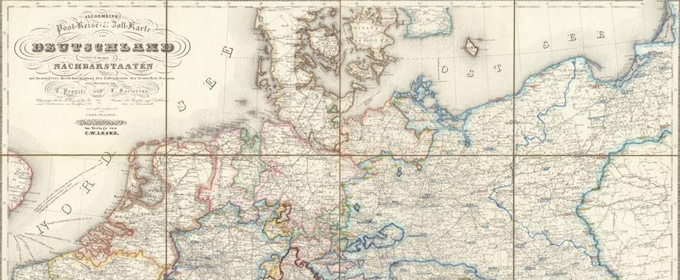Last week, the beta version of Germany’s new national digital library, the Deutsche Digitale Bibliothek (DDB) launched.
Unlike many of the other new digital platforms I’ve blogged about recently, which provide a single body of content (the collection of a specific museum, Shakespeare’s ouvre, etc.) the DDB functions as a central content hub for a truly decentralized corpus of resources. While there are a few clear centers from which the DDB’s resources originate (Berlin, Dresden, Stuttgart…), a look at the DDB’s map of contributing institutions shows a combination of libraries, museums, and archives distributed fairly evenly throughout Germany.
The content, meanwhile, is pretty stellar. I ran a few quick searches of general terms and major landmarks to get a sense of what’s available on the site. The Beta version is available in English, but search results in English are, at least for the moment, somewhat limited. (For example, a search for “Landschaftsbild” yielded 326 results, but a search for the corresponding “landscape” yielded only 124.) A search for “Kölner Dom” (Cologne Cathedral) meanwhile, brought me to 77 documents, including a gorgeous series of mid 19th century architectural drawings and an 11th century manuscript portrait of the archbishop of Cologne.
While each resource is hosted on the DDB site, all images link back to the data providers’ websites. It makes finding related images relatively simple — the link to the Marburg photo archive, the site that hosts the 11th century portrait of the archbishop, resulted in a 20 minute search through the archive’s other early medieval manuscripts.
The map of the DDB’s 1,800+ contributing institutions seems like it could be one of the platform’s greatest assets, if not for a pretty major shortcoming. The map allows users to click through various levels of geographic specificity before finally choosing a single library’s collection. While it seems like the DDB should present the resources provided by the institution you’ve chosen (and I keep clicking through the map hoping something will change to make this the case), instead the DDB provides information about the institution itself. Even though this feature leaves me wanting, so far the DDB as a whole seems like an incredible resource for German cultural and scientific heritage resources.
Image: “Allgemeine Post-Reise und Zoll-Karte von Deutschland,” courtesy of the DDB and the Bayerische Staatsbibliothek
